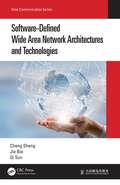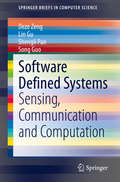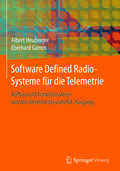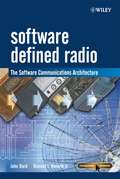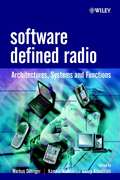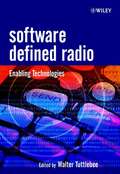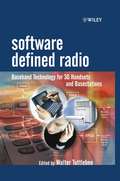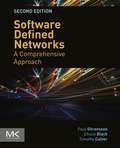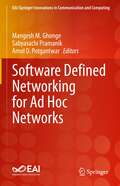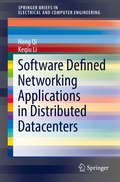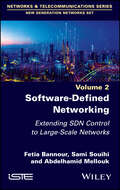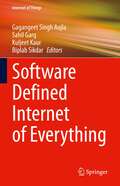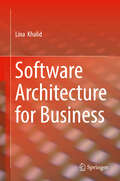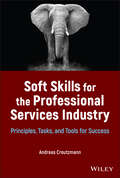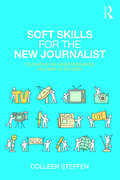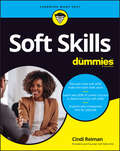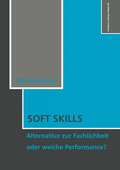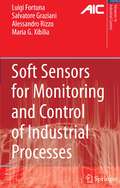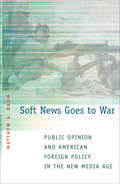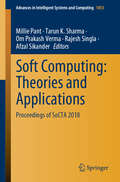- Table View
- List View
Software-Defined Wide Area Network Architectures and Technologies (Data Communication Series)
by Cheng Sheng Jie Bai Qi SunStarting with problems and challenges faced by enterprise WANs, Software-Defined Wide Area Network Architectures and Technologies provides a detailed description of SD-WAN’s background and basic features, as well as the system architecture, operating mechanism, and application scenarios of the SD-WAN solution based on the implementation of Huawei SD-WAN Solution. It also explains key SD-WAN technologies and analyzes real SD-WAN deployment cases, affording readers with design methods and deployment suggestions for the SD-WAN solution. The information presented in this book is easy to understand and very practical. It enables you to become adept in the SD-WAN solution’s implementation and design principles. The book is intended for ICT practitioners, such as network technical support engineers, network administrators, and network planning engineers, to use in studying theory. Furthermore, it serves as reference material for network technology enthusiasts. Authors Cheng Sheng is the Chief Architect of Huawei’s SD-WAN Solution. He has nearly 20 years of experience in network product and solution design, as well as extensive expertise in product design and development, network planning and design, and network engineering project implementation. Jie Bai is an Architect of Huawei’s SD-WAN Solution. He is well versed in Huawei security products and SD-WAN Solution and has written books such as Huawei Firewall Technology Talk as well as Huawei Anti-DDoS Technology Talk. Qi Sun is a Senior Information Architect of Huawei, and he is knowledgeable in Huawei SD-WAN Solution, CloudVPN Solution, and Cloud Management Solution. He also participated in the information architecture design and delivery of multiple solutions.
Software Defined Systems: Sensing, Communication and Computation (SpringerBriefs in Computer Science)
by Deze Zeng Lin Gu Shengli Pan Song GuoThis book introduces the software defined system concept, architecture, and its enabling technologies such as software defined sensor networks (SDSN), software defined radio, cloud/fog radio access networks (C/F-RAN), software defined networking (SDN), network function virtualization (NFV), software defined storage, virtualization and docker. The authors also discuss the resource allocation and task scheduling in software defined system, mainly focusing on sensing, communication, networking and computation. Related case studies on SDSN, C/F-RAN, SDN, NFV are included in this book, and the authors discuss how these technologies cooperate with each other to enable cross resource management and task scheduling in software defined system. Novel resource allocation and task scheduling algorithms are introduced and evaluated. This book targets researchers, computer scientists and engineers who are interested in the information system softwarization technologies, resource allocation and optimization algorithm design, performance evaluation and analysis, next-generation communication and networking technologies, edge computing, cloud computing and IoT. Advanced level students studying these topics will benefit from this book as well.
Software Defined Radio-Systeme für die Telemetrie: Aufbau und Funktionsweise von der Antenne bis zum Bit-Ausgang
by Eberhard Gamm Albert HeubergerDieses Buch behandelt alle für ein Software Defined Radio (SDR) relevanten Systemteile: Antenne, Antennenanpassung, analoges Frontend, A/D-Umsetzung, Digital Downconversion (DDC), Interpolation, Synchronisation, Demodulation. Zunächst werden die notwendigen Grundlagen für die Darstellung von Signalen vermittelt sowie der gesamte Aufbau eines Software Defined Radios beschrieben, um anschließend die einzelnen Komponenten näher zu betrachten.Der Schwerpunkt des Buches liegt auf dem Zusammenspiel der Komponenten und Signale innerhalb des Empfängers. Zur Veranschaulichung der Signale wird das Open-Source-Programm GNU Octave verwendet.
Software Defined Radio: The Software Communications Architecture (Wiley Series in Software Radio #6)
by John Bard Vincent J. Kovarik JrThe Software Communications Architecture (SCA) establishes an implementation-independent framework for the development of Joint Tactical Radio System software configurable radios. It specifies the Operating Environment, services and interfaces that applications use. Software Defined Radio: The Software Communications Architecture focuses on the issues and benefits associated with developing a radio system in compliance with the SCA specification. This book provides a comprehensive, practical introduction to building a SCA-compliant system taking the reader through the historical and conceptual background to help filling in the gaps between the intent of the SCA specification and the practice. Key features: Presents a practical approach to the Software Communications Architecture Provides an example-oriented understanding of the usage of the SCA and thus allows the reader to extend the concepts and practice to more complicated multi-processor distributed environments. Covers the Operating Environment: a Core framework, CORBA middleware, POSIX operating systems and Domain profiles. Features an accompanying website with appendices, and links to further information on the SCA. This invaluable reference will provide applications programmers, designers, professional researchers, wireless manufacturers and operators with an indispensable guide to the Software Communications Architecture. Advanced undergraduate and postgraduate students on mobile and wireless communications courses will also find this to be an excellent guide to the topic.
Software Defined Radio: Architectures, Systems and Functions (Wiley Series in Software Radio)
by Markus Dillinger Kambiz Madani Nancy AlonistiotiSoftware defined radio (SDR) is a hot topic in the telecommunications field, with regard to wireless technology. It is one of the most important topics of research in the area of mobile and personal communications. SDR is viewed as the enabler of global roaming and a platform for the introduction of new technologies and services into existing live networks. It therefore gives networks a greater flexibility into mobile communications. It bridges the inter-disciplinary gap in the field as SDR covers two areas of development, namely software development and digital signal processing and the internet. It extends well beyond the simple re-configuration of air interface parameters to cover the whole system from the network to service creation and application development. Reconfigurability entails the pervasive use of software reconfiguration, empowering upgrades or patching of any element of the network and of the services and applications running on it. It cuts across the types of bearer radio systems (Paging to cellular, wireless local area network to microwave, terrestrial to satellite, personal communications to broadcasting) enable the integration of many of today's disparate systems in the same hardware platform. Also it cuts across generation (second to third to fourth). This volume complements the already published volumes 1 and 2 of the Wiley Series in Software Radio. The book discusses the requirements for reconfigurability and then introduces network architectures and functions for reconfigurable terminals. Finally it deals with reconfiguration in the network. The book also provides a comprehensive view on reconfigurability in three very active research projects as CAST, MOBIVAS and TRUST/SCOUT. Key features include: Presents new research in wireless communications Summarises the results of an extensive research program on software defined radios in Europe Provides a comprehensive view on reconfigurability in three very active research projects as CAST (Configurable radio with Advanced Sodftware Technology), MOBIVAS (Downloadable MOBIle Value Added Services through Software Radio and Switching Integrated Platforms), TRUST (Transparently Re-configurable Ubiquitous Terminal) and SCOUT (Smart User-Centric Communciation Environment).
Software Defined Radio: Enabling Technologies (Wiley Series in Software Radio)
by Walter H. W. TuttlebeeSoftware defined radio (SDR) is one of the most important topics of research, and indeed development, in the area of mobile and personal communications. SDR is viewed as an enabler of global roaming and as a unique platform for the rapid introduction of new services into existing live networks. It therefore promises mobile communication networks a major increase in flexibility and capability. SDR brings together two key technologies of the last decade - digital radio and downloadable software. It encompasses not only reconfiguration of the air interface parameters of handset and basestation products but also the whole mobile network, to facilitate the dynamic introduction of new functionality and mass-customised applications to the user's terminal, post-purchase. This edited book, contributed by internationally respected researchers and industry practitioners, describes the current technological status of radio frequency design, data conversion, reconfigurable signal processing hardware, and software issues at all levels of the protocol stack and network. The book provides a holistic treatment of SDR addressing the full breadth of relevant technologies - radio frequency design, signal processing and software - at all levels. As such it provides a solid grounding for a new generation of wireless engineers for whom radio design in future will assume dynamic flexibility as a given. In particular it explores * The unique demands of SDR upon the RF subsystem and their implications for front end design methodologies * The recent concepts of the 'digital front end' and 'parametrization' * The role and key influence of data conversion technologies and devices within software radio, essential to robust product design * The evolution of signal processing technologies, describing new architectural approaches * Requirements and options for software download * Advances in 'soft' protocols and 'on-the-fly' software reconfiguration * Management of terminal reconfiguration and its network implications * The concepts of the waveform description language The book also includes coverage of * Potential breakthrough technologies, such as superconducting RSFQ technology and the possible future role of MEMS in RF circuitry * Competing approaches, eg all-software radios implemented on commodity computing vs advanced processing architectures that dynamically optimise their configuration to match the algorithm requirements at a point in time The book opens with an introductory chapter by Stephen Blust, Chair of the ITU-R WP8F Committee and Chair of the SDR Forum presenting a framework for SDR, in terms of definitions, evolutionary perspectives, introductory timescales and regulation. Suitable for today's engineers, technical staff and researchers within the wireless industry, the book will also appeal to marketing and commercial managers who need to understand the basics and potential of the technology for future product development. Its balance of industrial and academic contributors also makes it suitable as a text for graduate and post-graduate courses aiming to prepare the next generation of wireless engineers.
Software Defined Radio: Baseband Technologies for 3G Handsets and Basestations (Wiley Series in Software Radio)
by Walter H. W. TuttlebeeThe impending advent of GSM in the early 1990s triggered massive investment that revolutionised the capability of DSP technology. A decade later, the vastly increased processing requirements and potential market of 3G has triggered a similar revolution, with a host of start-up companies claiming revolutionary technologies hoping to challenge and displace incumbent suppliers. This book, with contributions from today's major players and leading start-ups, comprehensively describes both the new approaches and the responses of the incumbents, with detailed descriptions of the design philosophy, architecture, technology maturity and software support. Analysis of SDR baseband processing requirements of cellular handsets and basestations 3G handset baseband - ASIC, DSP, parallel processing, ACM and customised programmable architectures 3G basestation baseband - DSP (including co-processors), FPGA-based approaches, reconfigurable and parallel architectures Architecture optimisation to match 3G air interface and application algorithms Evolution of existing DSP, ASIC & FPGA solutions Assessment of the architectural approaches and the implications of the trends. An essential resource for the 3G product designer, who needs to understand immediate design options within a wider context of future product roadmaps, the book will also benefit researchers and commercial managers who need to understand this rapid evolution of baseband signal processing and its industry impact.
Software Defined Networks: A Comprehensive Approach
by Chuck Black Paul Goransson Timothy CulverSoftware Defined Networks: A Comprehensive Approach, Second Edition provides in-depth coverage of the technologies collectively known as Software Defined Networking (SDN). The book shows how to explain to business decision-makers the benefits and risks in shifting parts of a network to the SDN model, when to integrate SDN technologies in a network, and how to develop or acquire SDN applications. In addition, the book emphasizes the parts of the technology that encourage opening up the network, providing treatment for alternative approaches to SDN that expand the definition of SDN as networking vendors adopt traits of SDN to their existing solutions. Since the first edition was published, the SDN market has matured, and is being gradually integrated and morphed into something more compatible with mainstream networking vendors. This book reflects these changes, with coverage of the OpenDaylight controller and its support for multiple southbound protocols, the Inclusion of NETCONF in discussions on controllers and devices, expanded coverage of NFV, and updated coverage of the latest approved version (1.5.1) of the OpenFlow specification.Contains expanded coverage of controllersIncludes a new chapter on NETCONF and SDNPresents expanded coverage of SDN in optical networksProvides support materials for use in computer networking courses
Software Defined Networking for Ad Hoc Networks (EAI/Springer Innovations in Communication and Computing)
by Sabyasachi Pramanik Mangesh M. Ghonge Amol D. PotgantwarThis book offers a comprehensive overview of Software-Defined Network (SDN) based ad-hoc network technologies and exploits recent developments in this domain, with a focus on emerging technologies in SDN based ad-hoc networks. The authors offer practical and innovative applications in Network Security, Smart Cities, e-health, and Intelligent Systems. This book also addresses several key issues in SDN energy-efficient systems, the Internet of Things, Big Data, Cloud Computing and Virtualization, Machine Learning, Deep Learning, and Cryptography. The book includes different ad hoc networks such as MANETs and VANETs, along with a focus on evaluating and comparing existing SDN-related research on various parameters. The book provides students, researchers, and practicing engineers with an expert guide to the fundamental concepts, challenges, architecture, applications, and state-of-the-art developments in the field.
Software Defined Networking Applications in Distributed Datacenters (SpringerBriefs in Electrical and Computer Engineering)
by Heng Qi Keqiu LiThis SpringerBrief provides essential insights on the SDN application designing and deployment in distributed datacenters. In this book, three key problems are discussed: SDN application designing, SDN deployment and SDN management.This book demonstrates how to design the SDN-based request allocation application in distributed datacenters. It also presents solutions for SDN controller placement to deploy SDN in distributed datacenters. Finally, an SDN management system is proposed to guarantee the performance of datacenter networks which are covered and controlled by many heterogeneous controllers.Researchers and practitioners alike will find this book a valuable resource for further study on Software Defined Networking.
Software-Defined Networking 2: Extending SDN Control to Large-Scale Networks (pdf)
by Fetia Bannour Sami Souihi Abdelhamid MelloukSoftware-Defined Networking 2: Extending SDN Control to Large-Scale Networks
by Fetia Bannour Sami Souihi Abdelhamid MelloukSoftware Defined Internet of Everything (Internet of Things)
by Gagangeet Singh Aujla Sahil Garg Kuljeet Kaur Biplab SikdarThis book provides comprehensive discussion on key topics related to the usage and deployment of software defined networks (SDN) in Internet of Everything applications like, healthcare systems, data centers, edge/fog computing, vehicular networks, intelligent transportation systems, smart grids, smart cities and more. The authors provide diverse solutions to overcome challenges of conventional network binding in various Internet of Everything applications where there is need of an adaptive, agile, and flexible network backbone. The book showcases different deployment models, algorithms and implementations related to the usage of SDN in Internet of Everything applications along with the pros and cons of the same. Even more, this book provides deep insights into the architecture of software defined networking specifically about the layered architecture and different network planes, logical interfaces, and programmable operations. The need of network virtualization and the deployment models for network function virtualization is also included with an aim towards the design of interoperable network architectures by researchers in future. Uniquely, the authors find hands on practical implementation, deployment scenarios and use cases for various software defined networking architectures in Internet of Everything applications like healthcare networks, Internet of Things, intelligent transportation systems, smart grid, underwater acoustic networks and many more. In the end, design and research challenges, open issues, and future research directions are provided in this book for a wide range of readers
Software Architecture for Business
by Lina KhalidThis book illustrates the role of software architecture and its application in business. The author describes enterprise architecture along with business architecture to show the role of software architecture in both areas. The place of software architecture in business is outlined from many perspectives in this context. The book outlines quality attributes and how managers can use software architecture to build high quality products. Topics include business software architecture, dealing with qualities, achieving quality attributes, managing business qualities, software product line, Internet of Things (IOT), and Service Oriented Business Architecture. The book is intended to benefit students, researchers, software architects, and business architects. Provides quick and easy access to all the important aspects of software architecture in business;Highlights a wide variety of concepts of software architecture in a straightforward manner, for students, practitioners, or architects;Presents different applications of software architecture in business.
Soft Skills for the Professional Services Industry: Principles, Tasks, and Tools for Success
by Andreas CreutzmannSoft Skills for the Professional Services Industry Auditors, accountants, lawyers, consultants, and other highly educated and trained professionals frequently hold impressive credentials and offer clients specialized expertise in complex areas. At the same time, these professionals understandably focus on the analytical and technical components of their jobs, sometimes to the point of excluding or ignoring important soft skills critical to the success of their careers and practices. In Soft Skills for the Professional Services Industry: Principles, Tasks, and Tools for Success, veteran auditor and entrepreneur Andreas Creutzmann delivers an essential discussion of often overlooked professional competencies that can mean the difference between career, engagement, and business success or failure. In the book, you’ll find accessible guidance on critical soft skills that can make a difference between fulfilment and success and failure on a professional and personal level. You’ll learn to handle the blending of home and the home office, how to effectively manage staff, how to market yourself and your firm, practical strategies for client and colleague communication, and how to find happiness in your day-to-day work. Each chapter stands alone and can be read in any order. They provide professionals with invaluable skills for navigating the modern—and digital—reality of work, showing you how to combine your professional education with the latest research and common sense on everything from client management to firm marketing. Soft Skills for the Professional Services Industry uses the field of auditing as a template and guide, but it is highly relevant to all skilled professionals – including lawyers, consultants, medical professionals, and others. The book is a must-read for any knowledge worker trying to add to their toolbox of practical skills. Critical guidance for practicing professionals on how to build often overlooked soft skills Most highly educated and trained professionals aren’t lacking in analytical or technical skills. Lawyers know the law, accountants understand double entry bookkeeping, and doctors know anatomy. However, many of us are less familiar with often overlooked—and equally essential—soft skills: client management, communication, staff and employee management, and others. In Soft Skills for the Professional Services Industry, accomplished auditor, entrepreneur, and consultant Andreas Creutzmann walks you through how to build critical competencies, from self-marketing to balancing work and life when your office is in your house. The book is made up of numerous, self-contained chapters that can be read in any order, and it demonstrates how to navigate increasingly digital and insistent professional demands on your time, effectively manage client and colleague relationships, and sell new clients on the services your firm offers. An essential roadmap to achieving personal and career success, Soft Skills for the Professional Services Industry is an indispensable resource for lawyers, doctors, accountants, auditors, and any other extensively skilled professional. It offers practical tools in functional areas that are frequently neglected in formal professional training.
Soft Skills for the Professional Services Industry: Principles, Tasks, and Tools for Success
by Andreas CreutzmannSoft Skills for the Professional Services Industry Auditors, accountants, lawyers, consultants, and other highly educated and trained professionals frequently hold impressive credentials and offer clients specialized expertise in complex areas. At the same time, these professionals understandably focus on the analytical and technical components of their jobs, sometimes to the point of excluding or ignoring important soft skills critical to the success of their careers and practices. In Soft Skills for the Professional Services Industry: Principles, Tasks, and Tools for Success, veteran auditor and entrepreneur Andreas Creutzmann delivers an essential discussion of often overlooked professional competencies that can mean the difference between career, engagement, and business success or failure. In the book, you’ll find accessible guidance on critical soft skills that can make a difference between fulfilment and success and failure on a professional and personal level. You’ll learn to handle the blending of home and the home office, how to effectively manage staff, how to market yourself and your firm, practical strategies for client and colleague communication, and how to find happiness in your day-to-day work. Each chapter stands alone and can be read in any order. They provide professionals with invaluable skills for navigating the modern—and digital—reality of work, showing you how to combine your professional education with the latest research and common sense on everything from client management to firm marketing. Soft Skills for the Professional Services Industry uses the field of auditing as a template and guide, but it is highly relevant to all skilled professionals – including lawyers, consultants, medical professionals, and others. The book is a must-read for any knowledge worker trying to add to their toolbox of practical skills. Critical guidance for practicing professionals on how to build often overlooked soft skills Most highly educated and trained professionals aren’t lacking in analytical or technical skills. Lawyers know the law, accountants understand double entry bookkeeping, and doctors know anatomy. However, many of us are less familiar with often overlooked—and equally essential—soft skills: client management, communication, staff and employee management, and others. In Soft Skills for the Professional Services Industry, accomplished auditor, entrepreneur, and consultant Andreas Creutzmann walks you through how to build critical competencies, from self-marketing to balancing work and life when your office is in your house. The book is made up of numerous, self-contained chapters that can be read in any order, and it demonstrates how to navigate increasingly digital and insistent professional demands on your time, effectively manage client and colleague relationships, and sell new clients on the services your firm offers. An essential roadmap to achieving personal and career success, Soft Skills for the Professional Services Industry is an indispensable resource for lawyers, doctors, accountants, auditors, and any other extensively skilled professional. It offers practical tools in functional areas that are frequently neglected in formal professional training.
Soft Skills for the New Journalist: Cultivating the Inner Resources You Need to Succeed
by Colleen SteffenJournalism is a pool staffed by distracted lifeguards and no matter how fancy your school is, your first week in a real newsroom will feel like a shove in the small of the back into 15 feet of water. Most of us come up for air eventually, but if you’re like journalist and educator Colleen Steffen, you may still be left feeling like all that training in inverted pyramids and question lists left something important out: you! Journalism is people managing, wrestling truth and story out of the messy, confusing raw material that is a human being, and the messiest human involved can often be the reporter themselves. So it’s time to talk about it. Instead of nervously skirting the sizable EQ (emotional intelligence) portion of this IQ (intelligence intelligence) enterprise, Soft Skills for the New Journalist explores how it FEELS to do this strange, hard, amazing job—and how to use those feelings to better your work and yourself.
Soft Skills for the New Journalist: Cultivating the Inner Resources You Need to Succeed
by Colleen SteffenJournalism is a pool staffed by distracted lifeguards and no matter how fancy your school is, your first week in a real newsroom will feel like a shove in the small of the back into 15 feet of water. Most of us come up for air eventually, but if you’re like journalist and educator Colleen Steffen, you may still be left feeling like all that training in inverted pyramids and question lists left something important out: you! Journalism is people managing, wrestling truth and story out of the messy, confusing raw material that is a human being, and the messiest human involved can often be the reporter themselves. So it’s time to talk about it. Instead of nervously skirting the sizable EQ (emotional intelligence) portion of this IQ (intelligence intelligence) enterprise, Soft Skills for the New Journalist explores how it FEELS to do this strange, hard, amazing job—and how to use those feelings to better your work and yourself.
Soft Skills For Dummies
by Cindi ReimanSoft skills make the hard skills work! Soft skills are the personal qualities that make you a great communicator, problem solver, and leader on the job—and in your personal life. Soft Skills For Dummies helps you hone in on the traits you already have—or fine tune the ones that may need some extra attention—to market yourself as a workplace leader who&’s in touch with what today&’s employers are looking for: people who can lead and inspire through interpersonal communication, cultural awareness, time management, teamwork, critical thinking, and problem solving. • Sharpen the skills you need for a successful career • Improve your ability to work with others • Become a more confident job seeker and leader • Grasp the concept of soft skills through real-world applications, inspirational stories, and industry spotlights With content based on a time-tested curriculum designed to prepare you for work and life success, this book is packed with everything you need to build your soft skills to make the strongest impact possible.
Soft Skills For Dummies
by Cindi ReimanSoft skills make the hard skills work! Soft skills are the personal qualities that make you a great communicator, problem solver, and leader on the job—and in your personal life. Soft Skills For Dummies helps you hone in on the traits you already have—or fine tune the ones that may need some extra attention—to market yourself as a workplace leader who&’s in touch with what today&’s employers are looking for: people who can lead and inspire through interpersonal communication, cultural awareness, time management, teamwork, critical thinking, and problem solving. • Sharpen the skills you need for a successful career • Improve your ability to work with others • Become a more confident job seeker and leader • Grasp the concept of soft skills through real-world applications, inspirational stories, and industry spotlights With content based on a time-tested curriculum designed to prepare you for work and life success, this book is packed with everything you need to build your soft skills to make the strongest impact possible.
Soft Skills: Alternative zur Fachlichkeit oder weiche Perfomance? (Schulpädagogik #10)
Nach einer Zeitspanne intensiver Begründung und Evaluierung des pädagogischen Gehalts von Schule durch schulpädagogische Forschung deutet sich an, dass die Aufmerksamkeit der von Schule Betroffenen und Interessierten sich dauerhaft dem Kommunikations-, Konflikt- bzw. dem generellen Umgangsverhalten der Personen zuwendet, die im Handlungsfeld Schule agieren und leben. Das ist nicht neu, die Personalität von Schule hat immer schon im Mittel-punkt des Interesses von Akteuren und Adressaten schulischen Wirkens gestanden. Neu ist: Im außerwissenschaftlichen Diskurs hat sich der Begriff Soft Skills etabliert, die Politik hat ihn inzwischen fest vereinnahmt, die Erziehungswissenschaft hat ein nicht ganz geklärtes Verhältnis zu ihm, weil er nicht zu ihrem etablierten Begriffsrepertoire gehört, sondern einen Import aus anderweitigen Wissenschaftsfeldern darstellt, insbesondere der Betriebswirtschaft und der Wirtschaftspädagogik. Mittlerweile gelten Soft Skills, also die „weichen Umgangs-qualitäten“, als „Allzweckwaffe“ beruflichen Erfolgs und sind deshalb „natürliche“ Gegens-tände öffentlicher Bildung und Erziehung.Den damit korrespondierenden Fragen wendet sich der vorliegende Band zu. Die Autoren haben sich dabei keineswegs allein auf die Schule und die in ihrem Zuständigkeitsbereich geführte Zieledebatte beschränkt, sondern die Rückbindung an den Ort ihres Wirkens gesucht.Besonderes Augenmerk legt der Herausgeber auf die Lesbarkeit, um die Texte nicht nur Fachleuten an die Hand zu geben, sondern gleichermaßen auch Studierenden, Referendaren, Praktikern und interessierten Laien, um ihnen ein Forum für Argumente und Gegenargumente zu erschließen und den Diskurs in der Sache zu befördern.
Soft Sensors for Monitoring and Control of Industrial Processes (Advances in Industrial Control)
by Luigi Fortuna Salvatore Graziani Alessandro Rizzo Maria Gabriella XibiliaThis book reviews current design paths for soft sensors, and guides readers in evaluating different choices. The book presents case studies resulting from collaborations between the authors and industrial partners. The solutions presented, some of which are implemented on-line in industrial plants, are designed to cope with a wide range of applications from measuring system backup and what-if analysis through real-time prediction for plant control to sensor diagnosis and validation.
Soft News Goes to War: Public Opinion and American Foreign Policy in the New Media Age
by Matthew A. BaumThe American public has consistently declared itself less concerned with foreign affairs in the post-Cold War era, even after 9/11, than at any time since World War II. How can it be, then, that public attentiveness to U.S. foreign policy crises has increased? This book represents the first systematic attempt to explain this apparent paradox. Matthew Baum argues that the answer lies in changes to television's presentation of political information. In so doing he develops a compelling "byproduct" theory of information consumption. The information revolution has fundamentally changed the way the mass media, especially television, covers foreign policy. Traditional news has been repackaged into numerous entertainment-oriented news programs and talk shows. By transforming political issues involving scandal or violence (especially attacks against America) into entertainment, the "soft news" media have actually captured more viewers who will now follow news about foreign crises, due to its entertainment value, even if they remain uninterested in foreign policy. Baum rigorously tests his theory through content analyses of traditional and soft news media coverage of various post-WWII U.S. foreign crises and statistical analyses of public opinion surveys. The results hold key implications for the future of American politics and foreign policy. For instance, watching soft news reinforces isolationism among many inattentive Americans. Scholars, political analysts, and even politicians have tended to ignore the soft news media and politically disengaged citizens. But, as this well-written book cogently demonstrates, soft news viewers represent a largely untapped reservoir of unusually persuadable voters.
Soft News Goes to War: Public Opinion and American Foreign Policy in the New Media Age
by Matthew A. BaumThe American public has consistently declared itself less concerned with foreign affairs in the post-Cold War era, even after 9/11, than at any time since World War II. How can it be, then, that public attentiveness to U.S. foreign policy crises has increased? This book represents the first systematic attempt to explain this apparent paradox. Matthew Baum argues that the answer lies in changes to television's presentation of political information. In so doing he develops a compelling "byproduct" theory of information consumption. The information revolution has fundamentally changed the way the mass media, especially television, covers foreign policy. Traditional news has been repackaged into numerous entertainment-oriented news programs and talk shows. By transforming political issues involving scandal or violence (especially attacks against America) into entertainment, the "soft news" media have actually captured more viewers who will now follow news about foreign crises, due to its entertainment value, even if they remain uninterested in foreign policy. Baum rigorously tests his theory through content analyses of traditional and soft news media coverage of various post-WWII U.S. foreign crises and statistical analyses of public opinion surveys. The results hold key implications for the future of American politics and foreign policy. For instance, watching soft news reinforces isolationism among many inattentive Americans. Scholars, political analysts, and even politicians have tended to ignore the soft news media and politically disengaged citizens. But, as this well-written book cogently demonstrates, soft news viewers represent a largely untapped reservoir of unusually persuadable voters.
Soft Computing: Proceedings of SoCTA 2018 (Advances in Intelligent Systems and Computing #1053)
by Millie Pant Tarun K. Sharma Om Prakash Verma Rajesh Singla Afzal SikanderThe book focuses on soft computing and its applications to solve real-world problems in different domains, ranging from medicine and health care, to supply chain management, image processing and cryptanalysis. It includes high-quality papers presented at the International Conference on Soft Computing: Theories and Applications (SoCTA 2018), organized by Dr. B. R. Ambedkar National Institute of Technology, Jalandhar, Punjab, India. Offering significant insights into soft computing for teachers and researchers alike, the book inspires more researchers to work in the field of soft computing.
